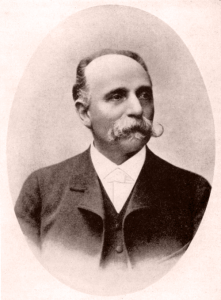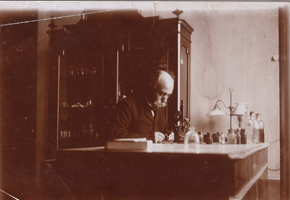
Camillo Golgi (Corteno, 1843 – Pavia, 1926) graduated in Medicine and Surgery in Pavia in 1865. He was at first assistant to Cesare Lombroso, before getting closer to Giulio Bizzozero; from the latter he learnt microscopic research techniques and methodologies.
Despite very flattering international feedback on some of his published work, his still uncertain position within the University of Pavia led him to try out for – and obtain – the position of chief physician at the Pio luogo degli incurabili Institute, in Abbiategrasso, a structure that accommodated patients afflicted by a vast array of chronic illnesses.
Here his research activity seemed destined to come to a halt, as the hospital did not have the technical instruments necessary. And yet Golgi persevered; in a rudimental laboratory which Golgi set up in his own apartment kitchen, in 1872 and 1873 he stubbornly continued his scientific work, eventually developing a selective staining technique for nervous tissues, the “black reaction”.
The technique allowed to investigate the elusive and complex structure of the nervous system. It consisted of immersing the tissue samples, previously soaked in potassium dichromate, in a 0,5 to 1 percent silver nitrate solution; this resulted in a dark staining of the tissues, highlighting all tissue details.
In 1876 Golgi was offered the role of Histology professor at Pavia University and, later, the chair of Histology and the corresponding Microscopy technique course. In 1879 he was given the chair of General pathology, which he held until he reached retirement age limit, in 1918.
The focus of his scientific work was the fine anatomy of the central nervous system. His results, gathered in a volume published in 1886, constitute a detailed description of the structure of spinal bone marrow, of the olfactory bulb, of the cerebral cortex and of the cerebellum, all made visible by “black reaction” staining.
It was because of his incredible research and of his innovative technique that, in 1906, Golgi was awarded a Nobel Prize for Medicine – together with Spanish researcher Ramón y Cajal, which whom unfortunately Golgi strongly disagreed on a number of scientific issues.
Between 1886 and 1893 he studied Malaria, discovering the monogamic development cycle of the plasmodium in quartan and tertian Malaria and the effectiveness of quinine on the parasites in the first phase of development.
In 1898 he first described the Golgi apparatus, one of the fundamental elements of the cell (by him originally named “internal reticular apparatus”).
In 1900 he was made Senator of the Kingdom for his recognized and celebrated scientific merits. He also held the position of President of the University of Pavia several times, and especially supported the construction of new buildings for the scientific faculties. He became the main manager of San Matteo Hospital, of which he started a reorganization that only death prevented him to see finished.
